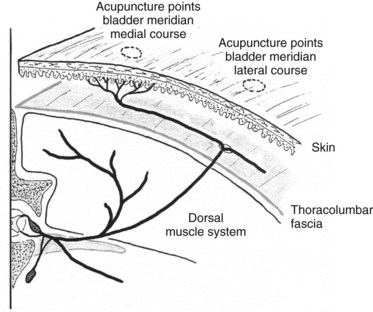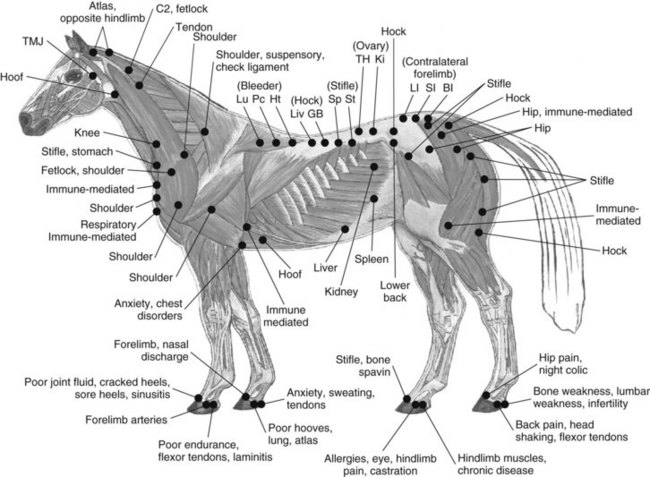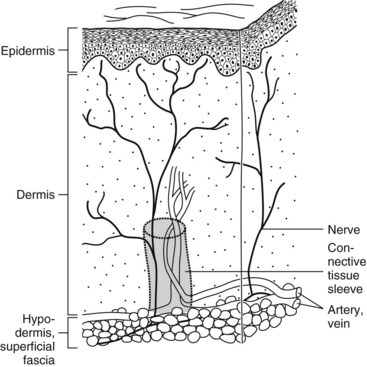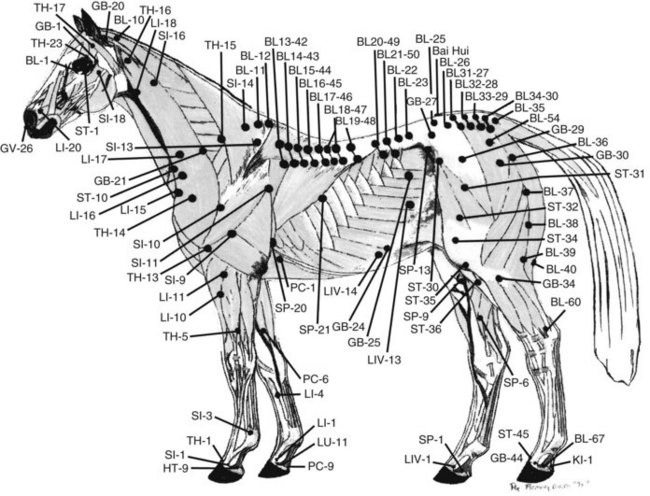Chapter 92Acupuncture
 Equine Acupuncture for Lameness Diagnosis and Treatment
Equine Acupuncture for Lameness Diagnosis and Treatment
Scientific Basis
Acupuncture may be defined in a Western medical perspective as the stimulation of specific predetermined points on the body to achieve a therapeutic or homeostatic effect. Recent research has provided evidence for the anatomical classification of acupoints. Acupuncture points are areas on the skin of decreased electrical resistance or increased electrical conductivity. Acupuncture points correspond to four known neural structures. Type I acupoints, which make up 67% of all acupoints, are considered motor points. The motor point is the point in a muscle that, when electrical stimulation is applied, will produce a maximal contraction with minimal intensity of stimulation. Motor points are located near the point where the nerve enters the muscle. Type II acupoints are located on the superficial nerves in the sagittal plane on the midline dorsally and ventrally. Type III acupoints are located at high-density foci of superficial nerves and nerve plexuses. For instance, acupoint GB-34 is located at the point where the common fibular (peroneal) nerve divides into the deep and superficial branches. Type IV acupoints are located at the muscle-tendon junctions, where the Golgi tendon organ is located.9 Recently, histological studies have revealed that small microtubules, consisting of free nerve endings, arterioles, and venules, penetrate through the fascia at acupuncture points (Figure 92-1).10
Acupuncture has many varied physiological effects on all systems throughout the body. No one mechanism can explain all the physiological effects observed. Traditional Chinese medical theories have explained these effects for 4000 years, based on empirical observations and descriptions of naturally occurring phenomena. Western medical theories include the gate and multiple gate theories, autonomic theories, humeral mechanisms, and bioelectric theories.10 Detailed discussions of the neurophysiological basis of acupuncture are reviewed in a number of texts.9-12 Essentially, acupuncture stimulates various sensory receptors (pain, thermal, pressure, and touch), which stimulate sensory afferent nerves, which transmit the signal through the central nervous system to the hypothalamic-pituitary system (Figure 92-2). The acupoints correlate with cutaneous areas containing higher concentrations of free sensory nerve endings, mast cells, lymphatics, capillaries, and venules. Various neurotransmitters and neurohormones are then released and have subsequent effects throughout the body. Research in rabbits using electroacupuncture-induced neural activation, detected by the use of manganese-enhanced functional magnetic resonance imaging, demonstrated a corresponding cerebral link between peripheral acupoints and central neural pathways. Research such as this is aiding in further understanding the effects of local peripheral stimulation on specific areas in the brain.13 Electroacupuncture has also been found to stimulate endogenous opioids, vasoactive peptides, adrenocorticotrophic hormone, cortisol, and catecholamine in cerebrospinal fluid and peripheral plasma in ponies.14 Bossut and colleagues15 documented changes in plasma cortisol and β-endorphin in horses subjected to electroacupuncture for cutaneous analgesia. Changes in serum protein and blood gas concentrations also have been demonstrated in donkeys after acupuncture.16,17 Xie and colleagues18 documented that electroacupuncture could relieve experimental pain in the horse via the release of β-endorphin. They found that acupuncture stimulation using local acupuncture points with high frequency (80 to 120 Hz) is more effective than using distal points with low frequency (20 Hz). They found that acupoints close to the painful areas require high-frequency electroacupuncture stimulation, whereas the acupoints far from the painful areas may be stimulated with low-frequency electroacupuncture. Electroacupuncture generally is considered to have stronger effects than other types of acupuncture methods.18 The degree of stimulation appears to depend on the location of the specific acupoints.19,20

Fig. 92-2 Cutaneous nerve entering the dermis at an acupuncture point along the bladder meridian.
(From Schoen AM, ed: Veterinary acupuncture: ancient art to modern medicine, ed 2, St Louis, 2001, Mosby.)
Traditional Chinese Medical Theories
In contrast, the Japanese technique, frequently termed meridian therapy, is based more on palpation of the acupuncture points and the reaction. The anatomical location of equine acupoints is based on the traditional Chinese acupuncture atlases or a transpositional atlas based on transcribing human acupuncture points onto the equine anatomy. The location of the points is similar in each method, though anatomical variation exists, as discussed by Fleming23 (Figure 92-3).
Techniques and Instrumentation
Manual therapies, such as chiropractic or osteopathy, are often applied along with acupuncture. They appear to work synergistically, acupuncture relieving muscle spasms and increasing circulation, chiropractic helping to correct skeletal fixations (see Chapter 93), and osteopathy affecting the fascia and skeletal structures (see Chapter 95). The combination of these therapies often leads to a more rapid response and greater efficacy, with fewer treatments required.
Clinical Applications in Lameness Examination and Treatment
Acupuncture Diagnostic Examination
Acupuncture and manual therapies may be used diagnostically to aid in evaluating various lameness and performance problems. Acupuncture is an excellent diagnostic aid as an adjunct to a conventional lameness examination. Many of the diagnostic acupoints are located lateral to the dorsal midline, between the longissimus and iliocostalis muscles, along the acupuncture meridian known as the bladder meridian.26 In addition, some diagnostic points are actually trigger points, knots or tight bands in a muscle. For instance, a triceps trigger point is often sensitive to palpation when a distal forelimb lameness is present and correlates with the acupoint Small Intestine 9. A triceps trigger point may not indicate exactly where the lameness is or what the cause is, but it does indicate that something is reactive in that region (Figure 92-4).

Fig. 92-4 Diagnostic acupuncture palpation points.
(Courtesy Peg Fleming. From Schoen AM, ed: Veterinary acupuncture: ancient art to modern medicine, ed 2, St Louis, 2001, Mosby.)
Diagnostic acupoints also are located around the coronary band on the forelimb and hindlimb, known as Ting points (Figure 92-5).15
Stay updated, free articles. Join our Telegram channel

Full access? Get Clinical Tree




